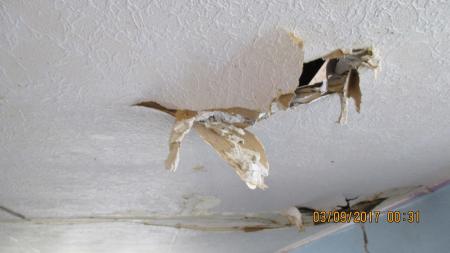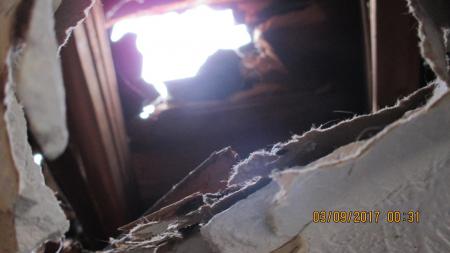I'm looking for a little advice on something.
A couple of days ago we had a really bad wind storm which brought a tree down onto the corner of my home that I share with my great aunt. Thankfully she wasn't there because she's currently at Rehab with a broken hip. Unfortunately for us, she didn't have Home Owner's insurance. The tree did damage to my roof, only just clipping it. A branch did go through it though, into my kitchen. The drywall ceiling was cracked and it currently bowed, possibly about to fall down. I'm having some trouble with cost and trying to figure out if I can in fact have it fixed before my aunt gets home on the 17th.
Regardless of the repairs though, she is coming home. I can't stop that, even though I tried.
I'm going to put some pics here. If anyone knows anything about this stuff, I was hoping they could tell me from the pictures if its safe to live in my house. I've been currently staying at my mother's for fear that the ceiling might fall on my head.







Comments
Have to investigate further
The drywall will probably stay in place. It depends on how well the original sheet was nailed up. You can get a ladder or sturdy chair and reach up and wiggle the loose sheet to see how sturdy it is. Set yourself and ladder outside the drop zone of each sheet in case it does fall.
In the top right picture you posted, set up on the right side of the loose parts. If the sheet does fall it should swing toward the part that is still fastened. If the sheet is 4x8 1/2 inch thick it shouldn't be terribly heavy if it does fall (about 50 lbs). Even if it is very loose and does fail, probably the whole sheet will not fall. They normally crack in smaller pieces and fail or fall in a piecemeal manner, even when you are trying to pull them down by hand. Set up a drop cloth to catch loose material. There will be some plaster dust if the sheet is disturbed. Unless you have very old popcorn type texture on the ceiling with asbestos the dust should be non toxic, but it is fine and messy.
Try to get the roof hole fixed immediately. Water coming through will get the sheet rock soggy and will very much weaken and stain what is there. You may have to rip out much more if any mold develops.
There could be damaged roof rafters too. Shine a light up into the attic and look for any cracked rafters near where the branch hit the roof.
I am also looking at what I see in the pictures and I am assuming that there is no ceiling beam structural damage. If you see any ceiling joists (wood pieces) hanging down with the drywall, do not pull down on it, and you will probably need to get someone with experience to look at it.
You can also get someone to put a temporary T brace from floor to ceiling as a means to shore up what is hanging down in the short term. With your aunt coming home though it is not ideal, and if she were to fall against it that could be an issue.
The Kitchen
There's no attic space above the kitchen. My little brother thinks it might have been an old porch or sun room converted into a kitchen some years ago. The house is fairly old after all.
space
There is usually some small wedge shaped space between the rafters that hold up the roof and form the slope of the roof, and the ceiling joists that are usually horizontal that the wallboard is nailed to. Someone should try to look up in there near the roof hole to see if there is any structural wood damage (rafters or ceiling joists).
my first
Thing would be to get the tree clear of the building. You can't safely do anything else until that's safe. Who's tree is it? In theory they will be responsible but if it's your aunts - dang.
Tree moved at least get a tarp over the damaged roof - then you can worry about inside.
Madeline Anafrid Bell
Responsibility
Sorry Maddy, if the tree is owned by a neighbor and it falls on your house due to an act of God, (not some idiot with a chainsaw) the neighbor has no responsibility. I found this out the hard way, but unlike Ef. I have homeowner's insurance.
Karen
Depends
If the neighbor knew the tree was in bad shape and in danger of falling, then the neighbor could be liable. Hard to prove though. I had a friend in PA hold her neighbors insurance liable due to this. Though she had her own insurance, and her insurance went after neighbor's insurance.
Roof Repair
Before you do anything else, put a patch over the hole in the roof ! The ceiling is sheet-rock, easy to support, easy to fix. Get a helper first. then a piece of plywood 1 foot bigger all around of the falling ceiling. make two braced 2x4's shaped like a Y with a top. have these slightly longer than the normal floor to ceiling height. raise the patch slowly, then tap the 2x4's slowly to support the patch.
The last photo looks like no structural damage was done to the roof. This should buy you some time to arrange for professional repairs. Good luck ef. let me know you make out.
Big Hugs,
Karen
Repairs to house
1st tree needs to be supported, tied off (secured) so it can't roll or fall further into house.
2nd branches touching the house need to be cut back carefully. Clear the roof.
3rd and 4th fix roof & cut back the tree until it can't hit house
5 PRAY THERE IS NO ASBESTOS!!!
6 repair drywall and paint.
House is now weathertight, again. Now you can leisurely dispose of the tree trunk, stump and hole from stump in your leisure suit (couldn't resist).
I have no idea what had caused disappearance of my comment..
Bug? My mention of the other country with different building codes?
Anyway. As it is still not a July, you need to remove tree trunk and make sure that roof is waterproof untill you can start repairs. After the roof is repaired you can look at alternatives for plasterboard ceiling... There are cheaper and more aesthetically nice options then just a painted plasterboard...
Green grass in the yard
Means you aren't anywhere near somewhere I could get to, more's the pity. Got me a good chainsaw and a couple of cousins who'd be happy to take care of that tree now that it's well recorded. I'd suggest finding someone with a ladder and a tarp quick, though, rain + plasterboard = major mess fairly quickly. Tuck the upper edge of the tarp, or whatever is being used to patch, under the edge of the solid shingles over the damaged area, if possible. The structure doesn't look damaged, from what I can see in the pictures, and plasterboard can be tougher than you might think ... depends on how well it was installed.
How much dyi can you do?
How much dyi can you do? Can you get help with tree?
DYI
My neighbor claims he can help with the tree but I'm not very optimistic about it be honest. The man has a tendency to suggest help then takes weeks to get around to actually doing it. As for the tarp, I bought one of those yesterday.
More Pictures of the House
So I was staying at my mother's and came home to find the tree off the roof and a tarp up there...thanks to the neighbor.
Good start
I hope the rest of the job goes well for you.
Get An Arborist
Have an arborist come out ASAP to determine if the tree was healthy or if it was diseased and whether or not the neighbor should have been aware of the state of the tree. If the tree wasn't healthy and there is/ was evidence of the condition of the tree, the neighbor is most likely liable. Laws on liability on falling trees vary from state to state and it is critical that you have and unbiased, expert opinion on the cause of the tree failure to keep your neighbor or his insurance company from avoiding liability.
Good luck getting thins sorted out.
The Tree
I called the City Engineer's office and he looked on a map for me, sadly the tree was not on my neighbor's property. They are pretty old looking trees though.
You're not going to like this
You're not going to like this suggestion, but I've done various repairs in sheetrock, and in the long run, this will be a LOT simpler.
Cut the sheetrock out. I mean, completely (not the entire roof), so that you've exposed enough beams that you have half a beam showing at the edge, and preferably one full beam. (that's roughly two feet across) Cut the sheetrock back along that section -along- the beam so that you've exposed the damaged roof completely. You need to do this to make sure of how far the damaged roofing extends. Once you've gotten that hole open, you can clear out the damaged plywood underneath (the torn up stuff). if the damage doesn't extend across a beam (hard to tell from that last picture - that's why you need to clear the next section), then you're in decent shape. A patch can be put across the hole on top of the roof. That'll require some new shingles as well. To properly patch the hole, you'll need to use a rotary saw ('skil-saw') set to the depth of the plywood. Cut a rectangular hole that extends from -half- of a beam on either side of the hole. That half beam is important for both the sheet-rock and the plywood. It leaves the rest of the ceiling/roof supported, while giving you enough surface to support the patch.
Once you've patched the hole, caulk the joint, and put in new shingles. If you've done this before, you can slide new shingles under the old and staple them into place. If you haven't done it, find a roofer who has.
Then you can worry about the sheet-rock inside. Just cut out a new piece the size of the hole, fit it up into place, and screw or nail in place. It can be taped and mudded later. A second person helps with this task. Oh - there are three thicknesses of sheetrock. Be sure you get the same as the old. (from the looks of it, you could shove some insulation in there too)
I'll get a life when it's proven and substantiated to be better than what I'm currently experiencing.